The Visceroptosis Webpage ©
The word visceroptosis is derived from the Latin word ‘viscus’ which refers mainly to the internal organs of the abdomen, and the ancient Greek word ‘ptosis’ which means ‘fall’.
i.e. literally – the abdominal organs have fallen to a lower part of the abdomen.
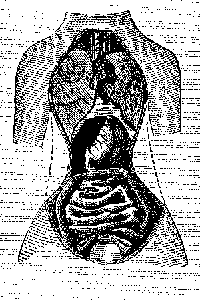 | 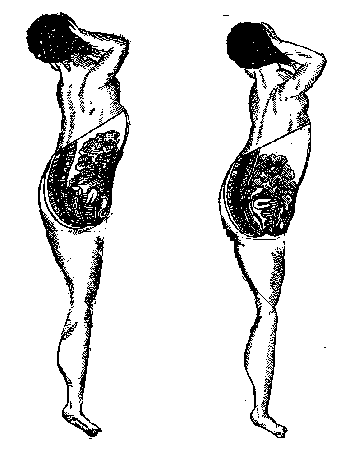 | ||
Corsets and visceroptosis Corsets compressed the internal organs of nineteenth century women, forcing some upwards, and some downwards. Eventually the attachments which held them in position stretched, and the upper abdominal anatomy fell to the lower abdomen |
|
In his book called “Madre Natura versus The Moloch of Fashion, which was published in 1874, Luke Limner writes . . . “The number of Diseases caused by Stays and Corsets according to the testimony of eminent medical men is astonishing.” Between pages 70 and 73 he provides a list of more than 100 ailments which are divided into sections about diseases of the head, the chest, and the abdomen, and sections about women’s illnesses and general diseases. The affects of compressing the womb included miscarriages, difficulty with childbirth, and the bearing of unhealthy children. That book is now available on the internet. See here |
The main causes of visceroptosis

| Left diagram The normal position of the internal organs | Right diagram The position of internal organs which have been permanently pushed lower into the abdomen by poor posture (visceroptosis) |
Visceroptosis was common and widely known to cause horrendous health problems in the nineteenth century.
The main cause was tight waisted whalebone corsets which compressed womens waists to as small as 12 inches or less, and literally squeezed some of the anatomy of the mid abdomen upwards, and some downwards.
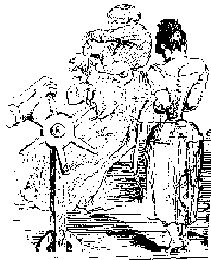
Many women wore corsets day and night for most of their lives, so the attachments which held their internal organs in place became permanently stretched, and when they took off their corsets they simply fell loosely downwards.

The life expectancy was directly related to the waist size of those garments, where women who wore 13 inch corsets generally died by the age of 35.
When corsets went out of fashion between 1904 and 1914 visceroptosis became less common in it’s severe form, but is still common, although nowadays it is not widely known about or understood as a cause of chronic health problems.
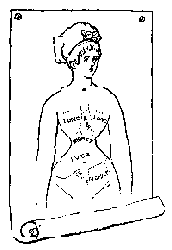 | 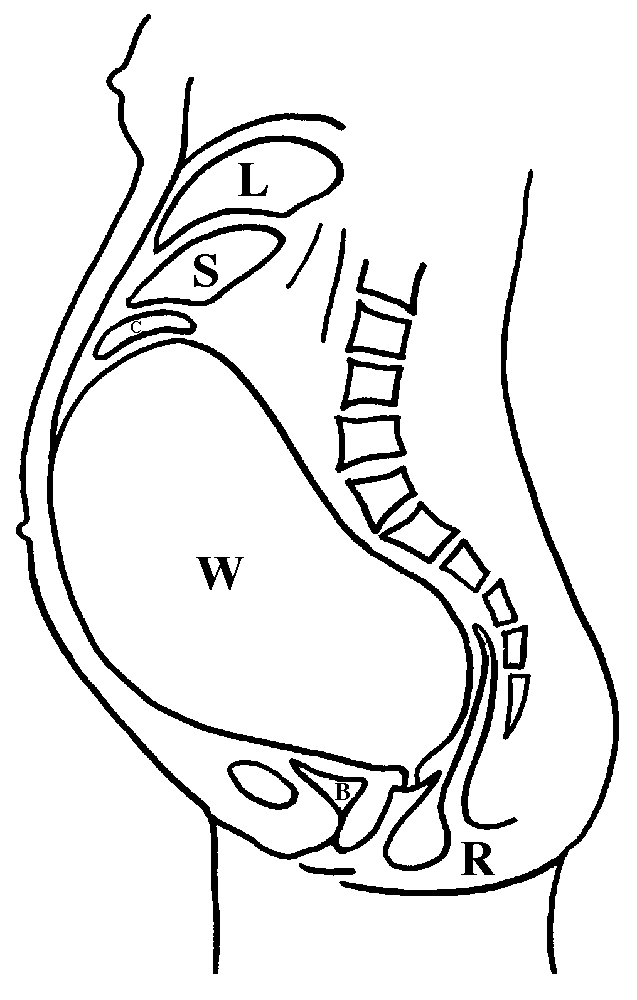 |
| Diagram of visceroptosis from outside. See more from the 1874 book here | The enalarging womb of pregnancy also compresses anatomy |
The internal organs can also be compressed and displaced by poor posture, the enlarging womb of pregnancy, and a variety of other factors. This displacement may stretch the attachments which hold the stomach, liver, and kidneys etc. in their proper place in the upper abdomen, and as a result they become suspended in a lower position. This produces a tendency for the kinking of tubular structures, ducts, blood vessels, and nerves and may lead to various problems such as indigestion, kidney problems, breathlessness and faintness.
However there has been much dispute about this, with the current consensus of opinion being that the condition is trivial, and not a cause of chronic illness. In reviewing this matter I found a 1930’s book, and have summarised the information to give a report on the history of the subject.
A Review of a 1930 book on the history of Visceroptosis ©
This essay is from the 11th edition of The Posture Theory pages 259-261
In a book called Visceroptosis and Allied Abdominal Conditions Associated with Chronic Invalidism, published in 1930, the author H. Bedingfield gives an account of the history of ideas on that subject from the 16th century to the early 20th century.
According to the author, 16th century writers claimed that the internal organs belonged in particular positions, and any variation in location was regarded as abnormal.
In 1837-41 French writer P.F. Rayer observed that a movable kidney was commoner for the right kidney and commoner in men, and was associated with general visceroptosis and hypochondriacal symptoms which could be relieved by supporting the kidney with a suitable belt.
In 1841 J. Cruveilhier gave a precise account of transverse colons which zig-zagged across the abdomen or looped down into the pelvis. He concluded that that was due to corset wearing which compressed and displaced the liver, which in turn distorted and displaced the bowel.
In 1870 R. Chroback suggested that the movable kidney was the cause of hysteria. L. Landau published another article on nephroptosis (the displaced kidney) in 1881 which started a flood of literature on that subject, such that by 1897 A. Macalister was able to provide a select bibliography of 151 articles.
Between 1885 and 1899 Frantz Glenard wrote 30 articles and monographs on enteroptosis (displacement of the bowel). His early articles proposed that sections of the colon could bow under the weight of faeces, which would cause a sharpening and narrowing of the nearby bends or flexures. That would further impair the flow of faeces and increase the weight in that section causing a strain on its attachments. He proposed that the hepatic flexure was the weakest and would give way first, and as that section of bowel descended it would drag on the pyloric end of the stomach and then pull down the transverse colon, ultimately producing obstructive kinks. The stomach and bowel would then tend to dilate prior to those kinks and contract after them.
He later proposed that disturbed liver function altered the bowel function and led to similar mechanisms of displacement, and he noted that disturbance in the circulation of the liver and bowel was followed by reduction in the tone of the bowel. “Glenard was the first to suggest that muco-membranous colitis was not a clinical entity but simply one of the symptoms of enteroptosis.”
In 1903 Alex Blad of Copenhagen wrote a book called “On Enteroptosis” which referred to some 800 articles on visceroptosis and by 1912 H. Burckhardt of Berlin presented several hundred more. However interest in that subject then began to wane. From 1913 J.E. Goldwaith and his Boston colleagues proposed that body shape influenced health, with a narrow back and chest cramping the lungs and heart, and resulting in poor aeration of the blood, and low blood pressure. He also proposed that such physique disposed to enteroptosis.
There were suggestions that a narrow upper abdomen may result in the abdominal viscera lying lower. The lowest part of the stomach would then be lower than its outlet so it may not empty properly. The lower bowels would necessitate kinking, and, would drag on the solar plexus, with the suggestion that that would cause neurasthenia (fatigue).
It was also thought that with normal posture the stomach was tucked up into the arch of the diaphragm and held in place by the vacuum created by its high dome formation. The small intestines were held in place by a shelf formed above a narrow waist which in turn supported the transverse colon and stomach, and, as the abdominal cavity inclines upwards and backwards, the kidneys and spleen have support from the posterior abdominal wall. Any alterations in posture would tend to remove these supports and then under the influence of gravity the viscera may drop to the lower abdomen.
In 1916 E.C. Koenig and N. Mankell attributed chronic intestinal disorders in children to visceroptosis, and F.B. Talbot, L.T. Brown and W.H. Sherman described how training in posture and carriage removed the children’s symptoms and restored their abdominal organs to their original position.
In 1927 H. Moore and F.E. Wheatley of Boston claimed that if the child was trained to maintain a correct posture from early life, and wore no constricting garments around the lower thorax, nor excessively heavy ones from the shoulders, visceroptosis “would not or could not happen.”
As well as considering the ideas about mechanical causes of visceroptosis, and visceroptosis as a cause of allied abdominal conditions, nervous disorders, neurasthenia and hysteria, the author also refers to various studies showing considerable variations in the position of internal anatomy between boys and girls, children and adults, men and women, and British and Americans, and concludes that differences between individuals represent a very wide range which can be regarded as normal.
There are references to individuals who have displaced anatomy yet have no symptoms with a further conclusion that variations in anatomy are compatible with normal health and were therefore not the cause of symptoms.
The postural ideas of the Boston doctors were dismissed by British orthopaedic surgeons who preferred “to regard posture and symptoms, not as cause and effect, but as expressions of an underlying cause”, namely psychological factors, with a further quote from A.S. Blankart “there is frequent association of postural deformity with neurasthenia and with a neuropathic family history”. (end of review)
The Boston exponents were also unable to explain all the diverse aspects of the condition, or why the abdominal symptoms were often accompanied by remote symptoms. However I note that the great majority of postural defects are acquired as the result of mechanical causes and that symptoms are a sequel, and that improvements in posture often relieve symptoms. The cause and affect between posture and symptoms would apply regardless of whether the postural defect was acquired or inherited.
The diverse aspects of visceroptosis are due to the multiple and diverse, often combined causes, and the remote symptoms emanate from abdominal disorders influencing the general health, and from the affects of postural mechanics on the entire body structure.
The ideas that corsets were a cause of visceroptosis were dismissed with the suggestion that many women with visceroptosis had never worn corsets.
However, I note that in 1903 it was possible to obtain 800 articles on visceroptosis and by 1912 there were several hundred more, after which such articles became rare.
There is clear evidence that the extensive interest in the subject in the 19th century was due to the extreme symptoms resulting from severe visceroptosis caused by the 19th century corsets. Between 1900 and 1914 as the abdominal crushing corsets faded out of fashion, the symptoms became less common and less severe, which would have obscured the link between cause and effect and explain why interest in the subject waned.
In the Medline Express computer data base which covers worldwide medical publications for the thirty year period from 1966 to 1995 less than 70 articles (i.e. less than an average of three per year) are listed under the heading of visceroptosis. In the Cumulated Index Medicus only one article is listed in 1993, and one in 1994. Medline Express lists none between January and October 1995.
I suggest that the current paucity of articles is not due to the rarity of visceroptosis but because the influence of the very common condition has been underrated and neglected. The indigestion and multiple other aches and pains which should properly be attributed to visceroptosis are being dismissed as the trivial or imaginary products of a supposedly disturbed mind, and where there is no evidence of that they are attributed to supposedly mysterious or sub-conscious psychological problems. M.B.
(note that when the internal organs have been pushed out of place the attachments which previously held them in their proper position have been stretched so that they hang loosely in the abdomen, hence they have been called loose, movable or floating kidneys or the wandering kidney etc. The displaced kidney is also referred to as such things as the “hypermobile kidney” and if it is displaced all the way down to the pelvic region it will be referred to as the pelvic kidney. Similar descriptions are applied the to the movable, floating, or wandering liver, or the floating spleen etc. The thoracic stomach is one that has been pushed up through the diaphragm so that some of it protrudes into the chest.
References
Bedingfield H. (1930) Visceroptosis and Allied Abdominal Conditions Associated With Chronic Invalidism, Humphrey Milford, Oxford University Press, London.
Limner Luke Esq. (1874) Madre Natura versus the molloch of fashion, 4th edition, Chatto and Windus, Picadilly, London.
Friel John P. (editor)(1962) Dorland’s Illustrated Medical Dictionary, 25th edition, W.B.Saunders Company, Philadelphia, London, and Toronto.
Banfield M.A. (2000) The Posture Theory, 11th edition, pages 259-261, published by M.A. Banfield, Adelaide, South Australia.
See also here http://radiology.rsna.org/content/15/2/223.extract
How I discovered this long forgotten topic
My interest in medicine began in 1975, and after making some personal observations, and reviewing the research literature of that time, I came to the conclusion that poor posture was compressing the chest and abdomen to cause a very large range of health problems, and after having about one essay published each three months in the Australasian Nurses Journal, I wrote a summary which was published in June 1980, which I have since called The Posture Theory.
When i started talking about the idea the vast majority of people, inside and outside of science, including Sir Mark Oliphant, Australia’s most famous scientist, were generally impressed by it’s logic and common sense, and because it was a perfect explanation for a mystery.

More than ten years passed when I walked into an antique shop and saw a cupboard, with a book on top which was opened at a page which showed the outline of the human body of a woman who had worn corsets. It was drawn as if all the skin had been removed so that the crushing effect on internal anatomy could be clearly seen.
I immediately assumed that such women would have the same range of symptoms which I had attributed to the crushing effects of poor posture. I didn’t buy the book at the time, but found one at another antique shop several months later, and purchased it. I was not in the least bit surprised to find that corsets did cause the same sort of symptoms so I wanted to learn more. The displacement of the internal organs from their normal position was called visceroptosis so I looked for information on that subject and eventually found another book published in 1930 which summarised the ideas. The author mentioned that by 1903, when most women in Western countries were still wearing corsets, there were more than 800 articles on the subject published in Medical Research Journals.
Several hundred more were written in the next few years but corsets started going out of fashion and the interest in the subject declined until the mid 20th century when articles about it had become scarce. All of the information had been completely forgotten, or dismissed as irrelevant by a society where corset wearing had become a rarity. I therefore considered it important to bring this major cause of health problems, and the large volume of nineteenth century research literature to the notice of the medical profession and the general public.
The Treatment of Visceroptosis
In the nineteenth century the symptoms of visceroptosis were relieved by the woman removing her corset and kneeling on her hands and knees with her head and chest lowered, because this allowed the internal anatomy, which had been compressed into the lower abdomen, to slide toward the normal position in the upper abdomen.
The symptoms can also be relieved by laying on a bed with the head and shoulders propped up with pillows, and with two cushions placed under the knees to elevate them. This has the effect of relieving the pressure on the abdomen which occurs in people with poor posture who sit and lean forwards for long periods. Similarly the symptoms can be relieved by leaning back in a recliner chair with the knees slightly raised and the legs bent. M.B.
Surgical Treatment for Severe Visceroptosis
(extracts from The Posture Theory 11th edition p.261-262)
Gastroptosis – Occasionally, with downward displacement of the stomach, the stomach becomes adherent to structures in the pelvis and that may cause a sharp kink in the duodenum which impairs the emptying of the stomach. Where there are severe symptoms and x-ray evidence of gastric retention caused by the displacement, “gastric resection may be indicated”.
Coloptosis – Downward displacement of the stomach is usually associated with downward displacement of other abdominal organs, particularly the colon, and sometimes the transverse colon descends into the pelvis. Where there are definite symptoms accompanying prolapse of the stomach and colon as indicated by clinical and x-ray evidence, “operations for relief of the prolapse are very beneficial”. The types of operations which restore those organs with more natural supports to more normal positions result in less interference with their function than operations which introduce abnormal ligaments. Providing the surgical wounds are not strained and have an opportunity to heal properly, the stomach and colon should “remain in their replaced position”.
Nephroptosis – Excessive mobility of the kidney can interfere with its drainage, or cause persistent pain and gastrointestinal disturbances. Such problems can be relieved by an operation which restores the kidney to a more normal and more stable position.
Reference: Operative Surgery (1953) p. 758-761 & 1206
The fact that some symptoms can be relieved by operations which restore abdominal organs to their normal positions leaves no doubt that visceroptosis is a cause of symptoms and that the diagnostic term is valid, and that the degree of displacement influences the likelihood and severity of symptoms. M.B.
When the internal organs are loose or low in the abdomen the tubular structures are prone to kinking and temporary obstruction of the flow of fluids or solids through them. Hence when the duodenum, colon, appendix, gall duct, or kidney ducts are kinked the symptoms of visceroptosis can include dyspepsia, vomiting, and constipation, and can imitate the pain of appendicitis and the colic of gallstones and kidney stones, and if the visceroptosis persists it can cause neurasthenia.
Reference: The Illustrated Family Doctor (1935) p.698-699.
Surgical treatment for visceroptosis included caeco-colon fixation, and gastropexy which resulted in marked improvement for 6-9 months, after which symptoms became worse.
Reference: Visceroptosis and Allied Abdominal Conditions Associated with Chronic Invalidism (1930) p. 135
I suggest that the short term benefits of earlier surgical methods of relieving symptoms were due to the replacement of anatomy to its normal position.
The symptoms may have returned after 6-9 months because the individuals had kyphotic (stooped) postures, and continued to slouch, or continued to wear corsets which put strain on the new surgical attachments and caused them to give way again. M.B.
Visceroptosis An Outmoded Concept?
“Gastroptosis . . . downward displacement of the stomach; a term based on the outmoded concept that variation in the position of the abdominal organs is pathological”. Reference: Dorland’s Illustrated Medical Dictionary 25th edition (1974) p.636 | In 1921 A. Rowland of the James MacKenzie Institute who studied 974 private and public hospital patients found that “no less than 49.48% fell into the group reserved for cases showing uncoordinated symptoms with no recognisable cause.” Reference: Visceroptosis and Allied Abdominal Conditions Associated with Chronic Invalidism (1930) p. 108 |
The Chronic Fatigue syndrome and diagnosis and . . .
THE TILT TABLE TEST
From what I can recalI suggested the tilt table test as a means of diagnosing “Chronic Fatigue” more than thirty years ago in a series of articles that were published in the Australasian Nurses Journal.
The basis for that idea was that the condition was then known as ‘Neurocirculatory asthenia’ – The term neurocirculatory asthenia is derived from “neuro = nerve, circulatory = circulation of blood, and asthenia = weak. i.e. it means that the fatigue is caused by poor blood flow which is either due to a weak nervous system or weak blood vessels.
One of my theories was that poor posture was putting pressure on the air in the chest and blocking blood flow from the feet to the heart and brain, and hence putting strain on all of the blood vessels below the chest until they became weak.
In healthy people the blood flow is strong so it is maintained in all body positions, but when the flow is weak the movement of the body to the left results in too much blood flowing to the left side of the body, and when the body is tilted to the right it flows to the right side, and when the head is raised it rushes to the feet etc.
The temporary rush of blood away from its normal course results in less blood flowing toward the heart, and from the patients perspective it produces an alarming sensation in the chest as if the heart is about to fail. I therefore suggested that the chronic fatigue syndrome could be diagnosed by attaching blood pressure cuffs to the arms and legs, and the probes of a cardiograph to the chest of the patient while they were being rotated on a tilt table, because the pattern should be characteristically different to that of a healthy person, or to anyone with a different type of ailment.
The altered flow of blood in the body would be matched by corresponding alterations to the flow of blood to, and inside of the brain, so it would presumably alter the pattern of brain function. If that is so then the newly invented EVestG technique should be able to distinguish the brain patterns of chronic fatigue syndrome from mental disorders or other physical ailments.
Visceroptosis as a cause of tilt table symptoms
Visceroptosis is a condition in which the stomach and liver have been pushed out of their normal position in the abdomen, and hang down abnormally, and hence tend to swing like a pendulum. Therefore they could apply pressure on the lower abdominal veins and reduce blood flow upwards to the heart and brain and cause such symptoms as faintness. Furthermore any movement in the angle of a tilt table would result in the anatomy swinging in the direction of the tilt, and compressing the veins on the left or right side etc, thereby temporarily taking blood flow away from the upwards direction.
That ailment was one of the most common conditions of the nineteenth century because almost all civilised women wore the tight waisted whalebone corsets which crushed the waist and pushed the stomach downwards permanently. The stomach can also be pushed downwards by poor posture.
There were many research papers on that topic but when corsets went out of fashion in the early 1900’s the incidence and severity of the displacement and symptoms declined accordingly. Nowadays that problem would be just as common because of the wearing of tight belts and girdles etc, but the displacement would be less severe, and the symptoms would be attributed to other factors, such as ‘unknown causes’.
However, that problem could also be diagnosed on a tilt table because each time the table is tilted to the left the patients stomach and liver would swing to the left and put pressure on the blood vessels on that side of the abdomen and thereby reduce blood flow to the brain.
Hence the diagnosis of visceroptosis as a cause of the patients symptoms could also be confirmed by a tilt table test.
My reasons for suggesting tilt table testing
My own experience with tilt tables relates to an incident which occurred a few years after I developed the chronic fatigue syndrome. One night I awoke with pain in the right side of my back which was diagnosed as kidney stones. I was immediately given an injection of morphine which provided a few hours relief from the pain, but then I had to endure the constant severe pain for a week as I waited for a kidney x-ray appointment to confirm the diagnosis. The constant period of pain made the fatigue worse. Before having the x-rays I was given some fluid which contained a dye, so that the flow through my kidneys could be determined, and if the dye stopped flowing through my kidney it confirmed that it was blocked by a stone. As the physicians were taking the x-rays they tilted the bed up at different angles, and to the left and right, and each time I felt extreme sensations of weakness inside my chest, and also an extreme sense of faintness, and I knew that if my blood pressure was being measured at the same time, and if my chest was attached to cardiographs, the abnormalities would be evident, and hence it would be a useful way of assessing the existence, and severity of the faintness and fatigue.
I also related the tilt table experience to the same observations about faintness being caused by squatting, or by being a passenger in a car as it sped around curves in country roads, or as I sat in swirling side-show rides, or in any situation that involved sudden changes in gravitational or centrifugal forces.
A YouTube video of a type of Tilt table test
A YouTube video which explains the procedure can be seen here http://www.youtube.com/watch?v=LBTjIxFisnQ&feature=related
See more general information about tilt table testing here http://www.righthealth.com/topic/Tilt_test
A variation of the tilt table test
explains modern findings?
This section about the inventor of the year award has been written on 24th September 2010, several years after the latter part of the page.
On the Australian ABC TV programme called the “New Inventors”, of 23-9-10 host James Ologhlin, presented the Australian inventor of the year award to Brian Lithgow and Jayashri Kulkarni, for their invention called the EVestG technique. Brian is, Senior lecturer, Electrical and Computer Systems Engineering. and Jayashri Kulkarni is Professor of Psychiatry, The Alfred and Monash University, and the EVestG technique involve inserting a probe near the ear drum to record brain activity while the patient was seated in a chair that could be tilted in various directions. They found that the pattern of brain activity was consistent for particular disorders, such as schizophrenia and depression which enabled them to be diagnosed with 95-100% accuracy. Their instant diagnostic technique may replace methods which have previously taken weeks, years or decades. They also found that it enabled them to apply the appropriate medication for treatment.
This is an extract from the New inventors website . . . “Quote of the Week . . . “A man with a new idea is a crank…… until he succeeds.” – American author Mark Twain
See here http://www.abc.net.au/tv/newinventors/txt/s2909625.htm
The Wikipedia page about that TV programme can be seen here http://en.wikipedia.org/w/index.php?title=The_New_Inventors&diff=next&oldid=376090896
Using tilt table testing to identify different patterns for different ailments
Tilt table testing could be used to confirm that the chronic fatigue syndrome had a completely different pattern to psychological problems such as depression etc. It would probably also identify different types of CFS. M.B.
See also here

